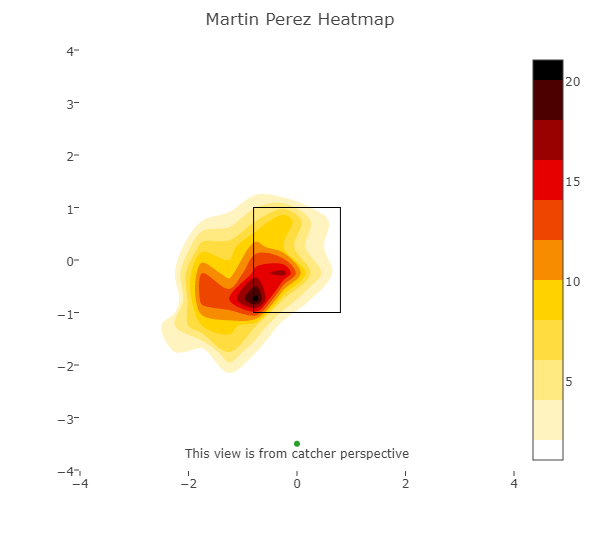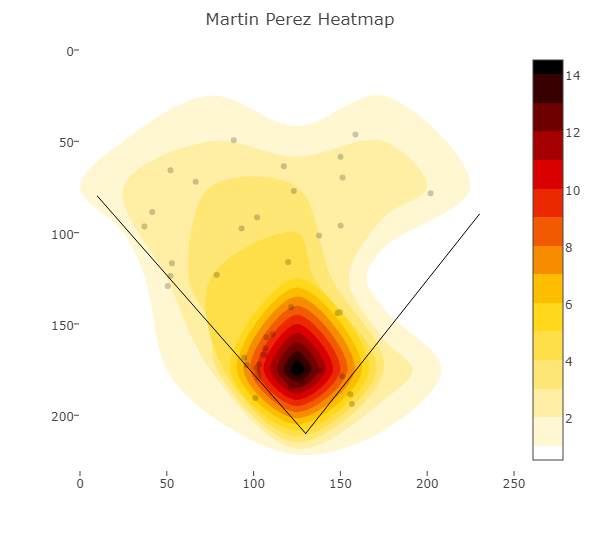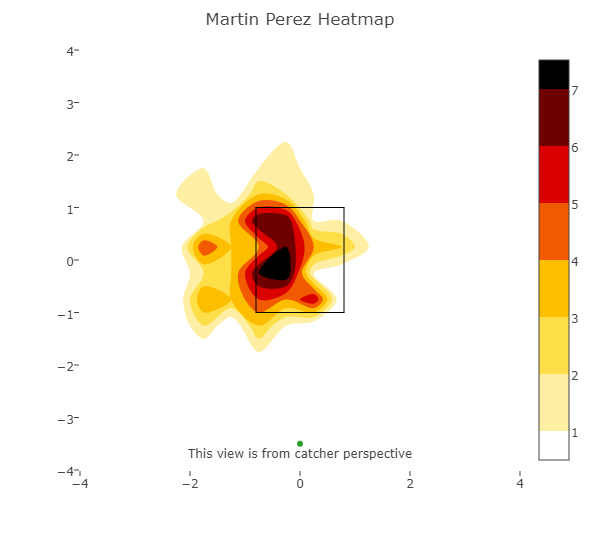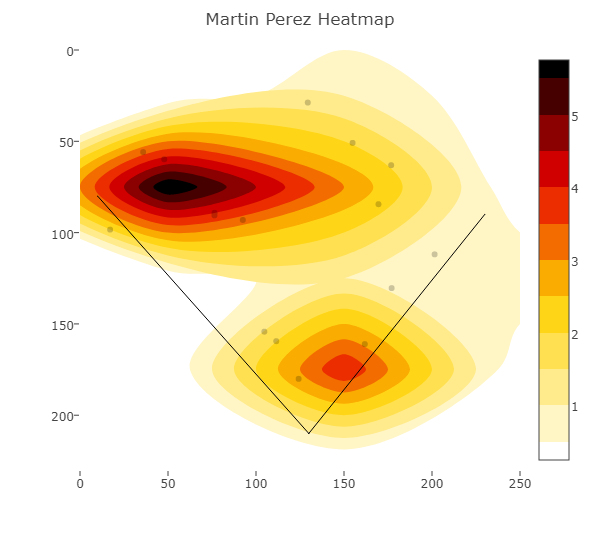If you haven’t been paying attention to Martin Perez this season, you’ve been missing out on a very interesting season from a guy absolutely no one expected to be as good as he has been.
So far this year, Perez is sporting a 2.83 ERA, 22.8% strikeout rate, and a 3.12 FIP. This is light years better than any season he’s had in the past. Last year in 15 starts with the Texas Rangers, Perez posted a godawful 6.22 ERA with a 5.72 FIP and a measly 13.2% strikeout rate. The year before wasn’t much either, with a 4.82 ERA, 4.65 FIP, and 14.2% strikeout rate over 32 starts in 2017.
So what exactly is happening here? How did a guy who has been a pretty terrible pitcher with an awful strikeout rate his entire career all of a sudden transform into a guy who, just a few days ago, pitched seven two-hit innings with nine strikeouts against the Toronto Blue Jays and the start before that, blanked the Houston Astros for eight innings while striking out seven?
The secret has been a brand new pitch he’s added this year, which has been absolutely fantastic: a cut fastball.
Martin Perez’s Magical Cutter
Perez signed a one-year deal with the Minnesota Twins this offseason, and that may have completely changed his career because it’s his move to the Twins that led to this new cutter. His agent, Felix Olivo, has been urging him to throw one for years, and once Perez moved to the Twins, he figured he might as well. His teammate Jake Odorizzi showed him how to throw the pitch to get inside on right-handers, and his pitching coaches helped him refine it.
And that cutter has been absolutely dominant. It’s the best cutter in baseball (and one of the best overall pitches in baseball) by pVAL at 11.4, and it counts as a Money Pitch, sporting a 45.3% chase rate, 45.8% zone rate, and 15.3% swinging-strike rate.
It has also completely changed Perez’s game. Before, Perez worked a sinker and four-seamer around the outside and tossed in a changeup, curveball, and occasional slider on the inside—nothing special for a left-handed pitcher.
But this cutter has allowed him to attack right-handed hitters on the inside, and it certainly doesn’t hurt that he’s locating it almost perfectly.

Right on the edge of the strike zone is where he’s typically putting that cutter. And when he locates it like that, it’ll freeze hitters like it does here:
https://gfycat.com/FarPersonalGourami
And here:
https://gfycat.com/OldfashionedMelodicCheetah
But it’s not just a pitch to freeze hitters—they’ll swing and miss at it too. Alongside a 15.3% swinging-strike rate, the pitch currently sports a 30.5% CSW, and when it rides, it can make hitters look stupid.
https://gfycat.com/DentalWholeFattaileddunnart
And even if hitters do make contact with the pitch, they’re not doing anything with it, currently sporting a .100/.156/.117 slash line against the pitch. While a .140 BABIP against the pitch might feel a little lucky, it’s also got a .157 xBA against, so not that lucky.
It’s no surprise that the stats against the pitch are so bad—hitters can’t get it out of the infield. Here’s a spray map of where hits against his cutter are going:

Basically nowhere. Which is exactly what someone like Perez wants out of his most-thrown pitch.
Is the New Cutter Enough?
One pitch does not a great starter make; you need more than that, and while Perez’s new cutter is clearly a fantastic pitch, the question remains: How good is the rest of his repertoire?
Well as far as other breaking pitches go, Perez has mainly been throwing a changeup with an occasional curveball. Neither has been particularly spectacular: His changeup has a 24.1% chase rate, which is pretty poor for a breaking ball; a 27.2% zone rate, which is also pretty poor if you don’t have an elite chase rate; and a 13.2% swinging-strike rate, which is solid.
Here’s a look:
https://gfycat.com/IdolizedLinedAmericancicada
As for his curveball, it’s a nice looking hook, as you can see here:
https://gfycat.com/WearySparklingBoubou
But it’s not really doing much of anything worthwhile, with a 29.6% chase rate and an 8.5% swinging-strike rate. When it comes to chase and swing-and-miss pitches, it’s all about Perez’s cutter, and that scares me a little when you don’t have another worthwhile offering. However, it’s not a reason to panic.
His other fastballs are where things get a little dicey. He throws a sinker and a four-seamer, and both have some pretty ugly stats against them so far this year.
We’ll start with his sinker:
https://gfycat.com/BoilingDefinitiveChickadee
It’s his second-most thrown pitch, and it can work pretty well sometimes, as you can see in the above GIF. But if you take a look at how hitters are doing against the pitch, it’s not great.
So far this year, hitters are slashing .341/.451/.439 against his sinker with a .392 wOBA against. That’s pretty rough, BUT I want you to know that these numbers are not truly reflective of Perez’s sinker, in my opinion.
The pitch is getting BABIP’d to death, like here:
https://gfycat.com/GreedyGrouchyAdouri
And here:
https://gfycat.com/BlissfulAridDoe
So far this year, hitters have a .433 BABIP against his sinker, and that’s just not going to stick. When you look at his xBA against, things look a lot better, as it’s currently sitting at .237 with a .313 xwOBA against.
Then, we have his four-seamer, and the numbers against that aren’t great either.
So far this year, opposing hitters are slashing .350/.409/.600 with a .425 wOBA against his four-seam fastball. But that’s also dying a death by 1,000 BABIPs with a .462 BABIP against; it’s not due for nearly the positive regression his sinker is, as it’s got a .283 xBA against.
And honestly, what I’m more concerned about is the .250 ISO and .614 xSLG it has against it. A lot of this has to do with his location of the pitch.

That’s … not ideal. And when hitters do make contact with the pitch, they absolutely crush it, to the tune of a 25% barrel rate.
https://gfycat.com/DeficientOrdinaryBumblebee
And Renato Nunez isn’t alone; while not every four-seamer goes for a home run, they’re almost all deep balls to left field:

That is not the spray chart you want to see for a pitch.
What Does it All Mean?
Here’s the short version of what you just read: Martin Perez has added a new pitch, and it is elite. As for the rest of his repertoire, he’s been getting pretty unlucky and some of that will stabilize, but there’s nothing else here to suggest that a sub-3 ERA is going to stick.
You may look at his 4.41 SIERA and get a little scared. I understand—that’s in part a function of his 4.7% HR/FB rate, but I don’t think he’s going to be that bad.
The four-seamer scares me, it really does, but he’s not using it a ton (just 15.8% of the time). As long as that keeps up (or that percentage gets lower) and the numbers around his sinker normalize some, he could be a useful player.
But there’s definitely risk here because if the rest of the league catches up to his cutter, he’s going to be in big trouble because he doesn’t have another great pitch to fall back on. However, I don’t think the league is going to catch up, at least not enough that he’s going to blow up. Is a mid-3 ERA with a decent strikeout rate doable? I think so, and that would make him pretty relevant in most leagues.
Featured image by Nathan Mills (@NathanMillsPL on Twitter)


So sell high?
I would say if you can find someone who thinks the sub-3 ERA is legit and this is Perez’s massive breakout, go for it and sell high. I do think there’s regression in order, but I also don’t think he’s going to regress to the pitcher he’s been the past couple years.
Otherwise, unless you can find someone who’s willing to overpay, I’d hang on to him
Great breakdown and great article Ben!
Thanks!